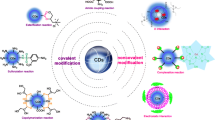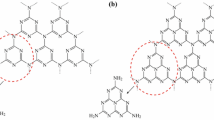Abstract
N, Cl-doped carbon dots (N, Cl-CDs) were prepared by hydrothermal method from rhodamine B (RhB) and ethylenediamine (EDA). The resulting N, Cl-CDs exhibited fascinating solvent dependence and strict excitation independence. As the polarity of the solvent increased (from tetrahydrofuran (THF) to water), the emission spectrum of N, Cl-CDs was redshifted and the fluorescence efficiency decreased, which were attributed to hydrogen bond-induced aggregation. Taking advantage of these attributes, the N, Cl-CDs were used as suitable probes for fluorescence and colorimetric dual-mode detection of water in THF. The linear relationship was 0.5–100% water with the detection limit down to 0.093%. Moreover, the sensing platform was converted into a paper-based sensor for handy, real-time, and visible humidity sensing. N, Cl-CDs/PVA films were fabricated and realized continuously tunable solid-state fluorescence, further expanding their practical application.
Graphical abstract









Similar content being viewed by others
References
Cigáň M, Gašpar J, Gáplovská K, Holekšiová J, Jakusová K, Donovalová J, Garaj V, Stankovičová H (2016) Coumarin phenylsemicarbazones: sensitive colorimetric and fluorescent “turn-on” chemosensors for low-level water content in aprotic organic solvents. New J Chem 40(10):8946–8953
Kim H, Lim K, Cho S, Kim J (2019) An anthracene appended guanidine derivative as water soluble fluorescence sensor for high pH values and water content measurements. J Photochem Photobiol A 383:112023–112029
Park H, Chang SK (2015) Signaling of water content in organic solvents by solvatochromism of a hydroxynaphthalimide-based merocyanine dye. Dyes Pigments 122:324–330
Kumar P, Ghosh A, Jose DA (2019) A simple colorimetric sensor for the detection of moisture in organic solvents and building materials: applications in rewritable paper and fingerprint imaging. Analyst 144(2):594–601
Wei J, Li H, Yuan Y, Sun C, Hao D, Zheng G, Wang R (2018) A sensitive fluorescent sensor for the detection of trace water in organic solvents based on carbon quantum dots with yellow fluorescence. RSC Adv 8(65):37028–37034
MacLeod SK (1991) Moisture determination using Karl Fischer titrations. Anal Chem 63(10):557–566
Jung H, Verwilst P, Kim WY, Kim JS (2015) Fluorescent and colorimetric sensors for the detection of humidity or water content. Chem Soc Rev 45:1242–1256
Frink LA, Armstrong DW (2016) Determination of trace water content in petroleum and petroleum products. Anal Chem 88(16):8194–8201
Kang E, Park H, Yoon J, Yu H, Chang S, Kim B, Choi K, Ahn S (2018) A simple method to determine the water content in organic solvents using the 1 H NMR chemical shifts differences between water and solvent. Microchem J 138:395–400
Snigur D, Zhukova Y, Studenyak Y, Chebotarev A (2020) Colorimetric determination of water in DMSO using 4-hydroxystyryl dyes. J Appl Spectrosc 87(3):407–411
Kumar P, Sakla R, Ghosh A, Jose D (2017) Reversible colorimetric sensor for moisture detection in organic solvents and application in inkless writing. ACS Appl Mater Interfaces 9(30):25600–25605
Divya T, Ramshad K, Saheer V, Chakkumkumarath L (2018) Self-reversible mechanochromism and aggregation induced emission in neutral triarylmethanes and their application in water sensing. New J Chem 42(24):20227–20238
Zhang Y, Li D, Yi L, Yu J (2014) Solvatochromic AIE luminogens as supersensitive water detectors in organic solvents and highly efficient cyanide chemosensors in water. Chem Sci 5(7):2710–2716
Yang J, Li Z, Jia Q (2019) Design of dual-emission fluorescence sensor based on Cu nanoclusters with solvent-dependent effects: visual detection of water via a smartphone. Sensors Actuators B Chem 297:126807–126814
Ullman A, Jones C, Doty F, Stavila V, Talin A, Allendorf M (2018) Hybrid polymer/metal-organic framework films for colorimetric water sensing over a wide concentration range. ACS Appl Mater Interfaces 10(28):24201–24208
Ma W, Jiang S, Zhang W, Xu B, Tian W (2020) Covalent organic frameworks with Electron-rich and electron-deficient structures as water sensing scaffolds. Macromol Rapid Commun 41(24):1–6
Arshad F, Sk MP (2019) Aggregation-induced red shift in N,S-doped chiral carbon dot emissions for moisture sensing. New J Chem 43(33):13240–13248
Senthamizhan A, Fragouli D, Balusamy B, Patil B, Palei M, Sabella S, Uyar T, Athanassiou A (2019) Hydrochromic carbon dots as smart sensors for water sensing in organic solvents. Nanoscale Adv 1(11):4258–4267
Wei J, Yuan Y, Li H, Hao D, Sun C, Zheng G, Wang R (2018) A novel fluorescent sensor for water in organic solvents based on dynamic quenching of carbon quantum dots. New J Chem 42(23):18787–18793
Pan D, Zhang J, Li Z, Wu C, Yan X, Wu M (2010) Observation of pH-, solvent-, spin-, and excitation-dependent blue photoluminescence from carbon nanoparticles. Chem Commun 46(21):3681–3683
Wang X, Wang D, Guo Y, Yang C, Iqbal A, Liu W, Qin W, Yan D, Guo H (2015) Imidazole derivative-functionalized carbon dots: using as a fluorescent probe for detecting water and imaging of live cells. Dalton Trans 44(12):5547–5554
Ye C, Qin Y, Huang P, Chen A, Wu F (2018) Facile synthesis of carbon nanodots with surface state-modulated fluorescence for highly sensitive and real-time detection of water in organic solvents. Anal Chim Acta 1034:144–152
Moniruzzaman M, Kim J (2019) N-doped carbon dots with tunable emission for multifaceted application: solvatochromism, moisture sensing, pH sensing, and solid state multicolor lighting. Sensors Actuators B Chem 295:12–21
Chao D, Lyu W, Liu Y, Zhou L, Zhang Q, Deng R, Zhang H (2018) Solvent-dependent carbon dots and their applications in the detection of water in organic solvents. J Mater Chem C 6(28):7527–7532
Wen Z, Song S, Wang C, Qu F, Thomas T, Hu T, Wang P, Yang M (2019) Large-scale synthesis of dual-emitting-based visualization sensing paper for humidity and ethanol detection. Sensors Actuators B Chem 282:9–15
Guan Q, Su R, Zhang M, Zhang R, Li W, Wang D, Xu M, Fei L, Xu Q (2019) Highly fluorescent dual-emission red carbon dots and their applications in optoelectronic devices and water detection. New J Chem 43(7):3050–3058
Wang J, Wang J, Xiao W, Geng Z, Tan D, Wei L, Li J, Xue L, Wang X, Zhu J (2020) Lignin-derived red-emitting carbon dots for colorimetric and sensitive fluorometric detection of water in organic solvents. Anal Methods 12(25):3218–3224
Geng X, Sun Y, Guo Y, Zhao Y, Zhang K, Xiao L, Qu L, Li ZH (2020) Fluorescent carbon dots for in situ monitoring of lysosomal ATP levels. Anal Chem 92:7940–7946
Jiang K, Wang Y, Cai C, Lin HW (2018) Conversion of carbon dots from fluorescence to ultralong room-temperature phosphorescence by heating for security applications. Adv Mater 30:1800783–1800790
Jia J, Lin B, Gao Y, Jiao Y, Li L, Dong C, Shuang S (2019) Highly luminescent N-doped carbon dots from black soya beans for free radical scavenging, Fe(3+) sensing and cellular imaging. Spectrochim Acta A 211:363–372
Jia J, Lu W, Li L, Gao Y, Jiao Y, Han H, Dong C, Shuang S (2020) Orange-emitting N-doped carbon dots as fluorescent and colorimetric dual-mode probes for nitrite detection and cellular imaging. J Mater Chem B 8(10):2123–2127
Liu JH, Li DY, He JH, Yuan D, Li RS, Zhen SJ, Li YF, Huang CZ (2020) Polarity-sensitive polymer carbon dots prepared at room-temperature for monitoring the cell polarity dynamics during autophagy. ACS Appl Mater Interfaces 12:4815–4820
Xu X, Hu G, Mo L, Li Y, Wei H, Lei B, Zhang X, Hu C, Zhuang J, Liu Y (2021) Red, orange, yellow and green luminescence by carbon dots: hydrogen-bond-induced solvation effects. Nanoscale 13:6846–6855
Yang H, Liu Y, Guo Z, Lei B, Zhuang J, Zhang X, Liu Z, Hu C (2019) Hydrophobic carbon dots with blue dispersed emission and red aggregation-induced emission. Nat Commun 10(1):1789–1799
Acknowledgements
This work was supported by the National Natural Science Foundation of China (No. 21874087), the Natural Science Foundation of Shanxi Province (201901D211155), and the research project supported by Shanxi Scholarship Council of China (2017 Key1). We appreciate Scientific Instrument Center of Shanxi University for us to identify samples.
Author information
Authors and Affiliations
Corresponding author
Ethics declarations
Conflict of interest
The authors declare no competing interests.
Additional information
Publisher’s note
Springer Nature remains neutral with regard to jurisdictional claims in published maps and institutional affiliations.
Supplementary information
ESM 1
(DOCX 3.75 mb)
Rights and permissions
About this article
Cite this article
Jia, J., Lu, W., Cui, S. et al. N, Cl-doped carbon dots for fluorescence and colorimetric dual-mode detection of water in tetrahydrofuran and development of a paper-based sensor. Microchim Acta 188, 324 (2021). https://doi.org/10.1007/s00604-021-04987-8
Received:
Accepted:
Published:
DOI: https://doi.org/10.1007/s00604-021-04987-8




